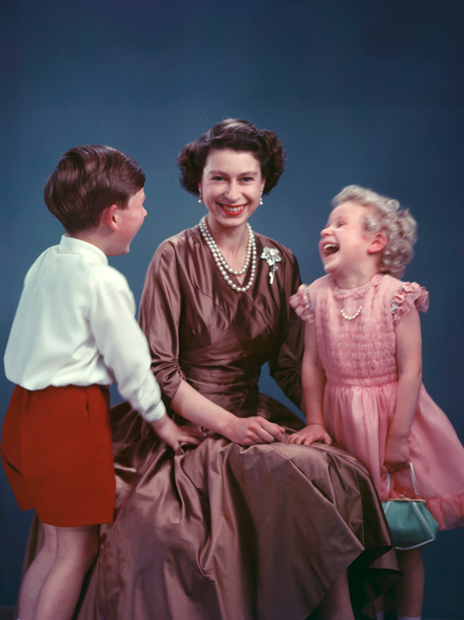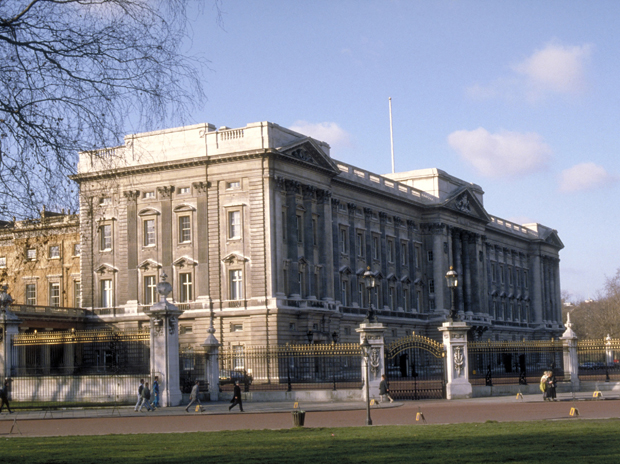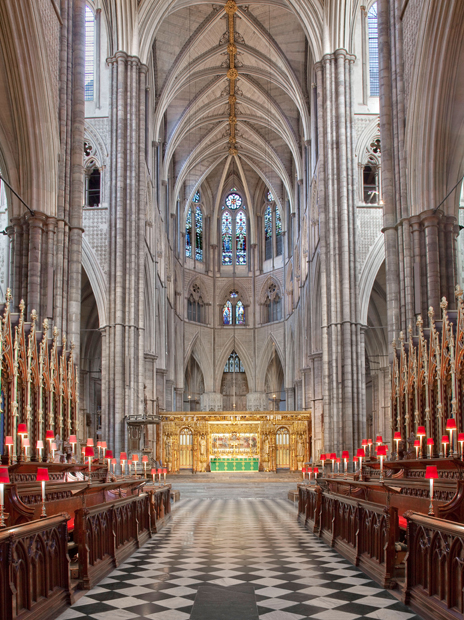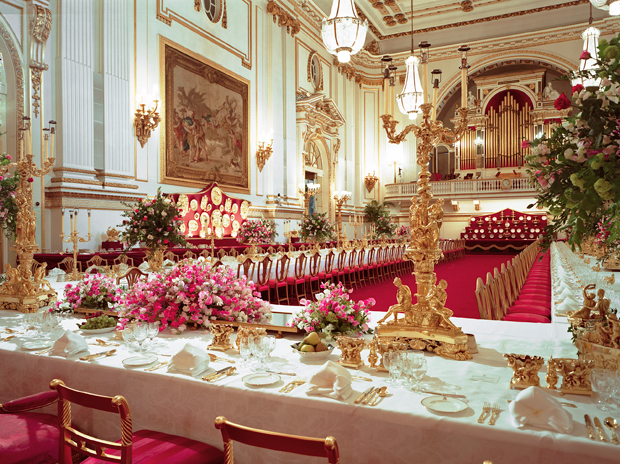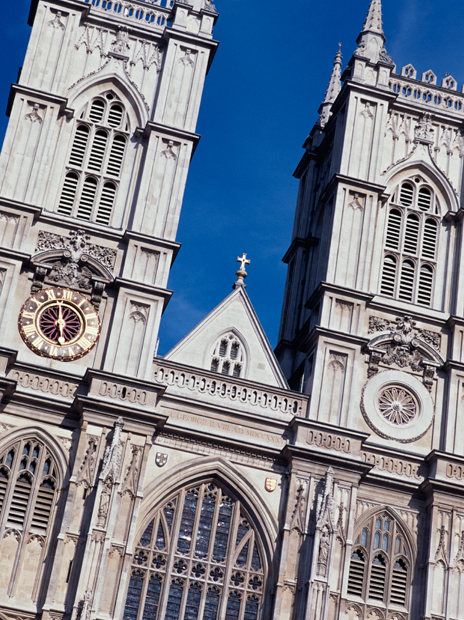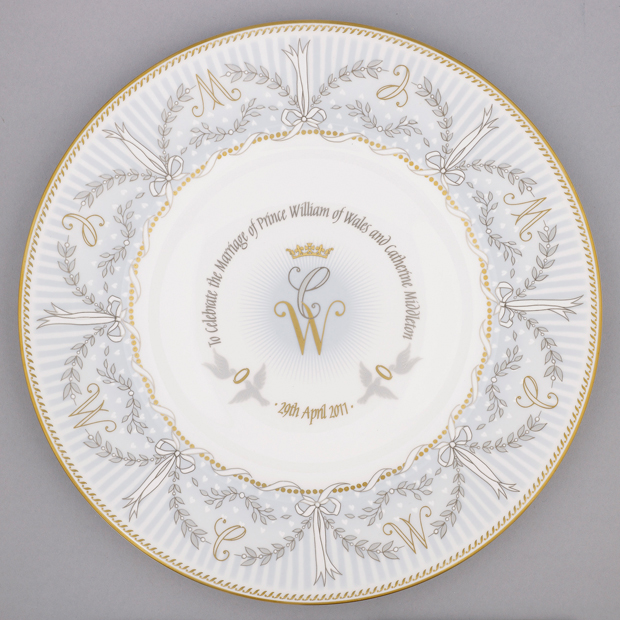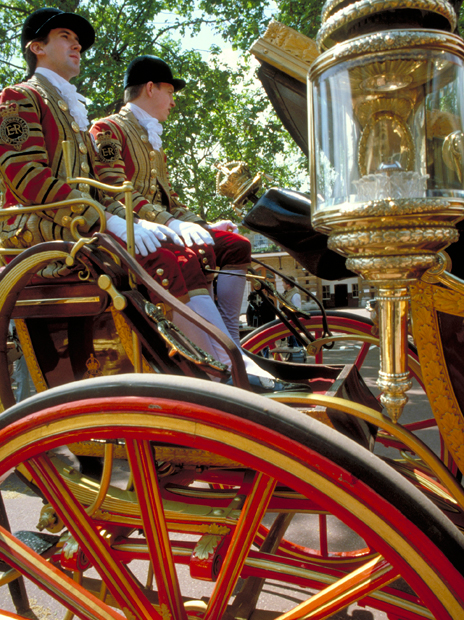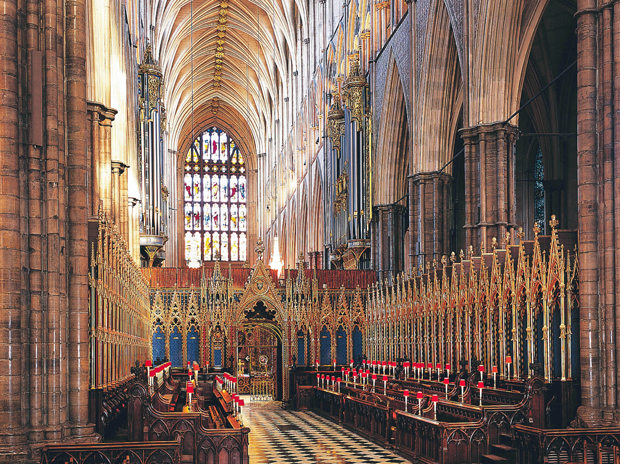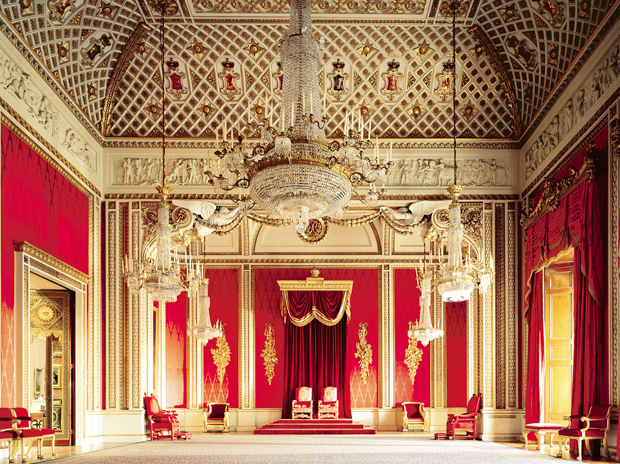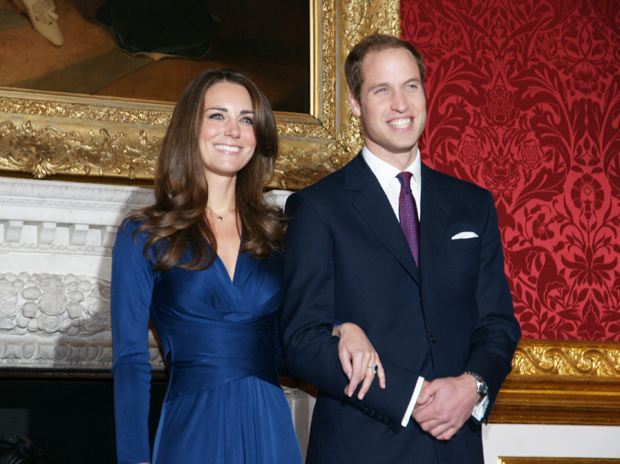Any wedding is a story of symbols and devotion - where two lovers stand before the symbols of love, sanctified in their culture by their gods, and declare devotion to their love for the infinitesimal eternity of a human lifetime.
A Royal Wedding, as well is a story about icons and service; the objects behind which stands a nation, and the people that serve them and are tied to them, whose noble lives are defined by them. It is a story of that which we strain our eyes looking for as we let our gaze wander up the social ladder, as if in a daydream, as the only manner of seeing what the gilded bride and bridegroom are seeing is to either be born at such heights already or be borne there by marriage.
The marriage on 29th April 2011 at 11.00 am of His Royal Highness Prince William of Wales with Miss Catherine Middleton, the union of the future King of England and future Princess of Wales, the mother of his future heir, is no different. To view it is, in many ways, to view every strata of the nation - from rain washed street to glistening balcony - whose future it so directly affects.
For any bride, the dress in which she will marry is of overpowering importance. For The future Princess of Wales and her dress, designed by Sarah Burton at Alexander McQueen, combining tradition and modernity, ivory and white satin gazar, this truth is magnified a thousand fold. Designed by Elizabeth and David Emanuel, the dress worn by Lady Diana, the former Princess of Wales, on the day of her wedding to Prince Charles, featured the sumptuous eight metre train of ivory taffeta and antique lace that helped create such fairytale images of the day. So fantastically abundant was the train that it filled to overflowing the equally fantastical Glass Coach, which she shared on her journey to St Paul’s Cathedral with her father.
This year, the bride travels to the ceremony with her father in a Rolls Royce Phantom VI, which was presented to The Queen in 1978 and reserved for use at prestigious royal occasions. Prince William, accompanied by his brother and best man Prince Harry, arrives in a Bentley.
Where they arrive also represents a return to tradition, with the ceremony being held in the magnificent Westminster Abbey - England’s spiritual cradle for more than a millennium. Originally a Benedictine monastery, it houses the shrine of its principal royal founder, St Edward the Confessor, who died in 1066. This began an extraordinarily personal connection between the Abbey and England’s rulers, and the good and great alike.
From William the Conqueror, the French duke who famously invaded England the same year, to Elizabeth II, every monarch has been crowned at the Abbey, with fifteen of those thirty-nine monarchs also lying entombed in its walls. Furthermore, key figures from British history - many cultural, social, political and scientific icons of global importance - also lie here; Geoffrey Chaucer, Sir Isaac Newton, Charles Dickens, George Frederick Handel and William Gladstone, to name just a few.
So, in the hallowed halls where the weddings of fifteen of his royal forebears have taken place since King Henry I, Prince William takes his bride and his place in history. The Archbishop of Canterbury, the most senior clergyman in the Church of England, presides over a ceremony attended by a glittering ABC of the world’s royalty. From The Crown Prince of Abu Dhabi, The Sultan of Brunei, The King and Queen of Norway, Prince Albert II of Monaco, The Queen of Spain, to Crown Prince Alexander and Crown Princess Katherine of Yugoslavia, the young Prince marries under the watchful gaze of his peers.
Also present are a select list of celebrities who hold personal significance to or relationships with the royal couple, including Sir Elton John, who sang so memorably at Prince William’s mother’s funeral, David and Victoria Beckham, and Guy Ritchie. Also present is the acclaimed photographer Mario Testino, who took the iconic official portrait of their engagement.
The 1,900-strong congregation bears witness as Prince William places on his bride’s finger the symbol of their union, a wedding ring - designed by Wartski - of rare and valuable Welsh Gold, a gift from The Queen to The Prince on the announcement of his engagement. This is a tradition that stretches back to the wedding ring used by The late Queen Mother, and continued with The current Queen, The late Princess Margaret, The Princess Royal and The late Princess of Wales, whose rings were all made from the same nugget of Welsh Gold.
Sound is as powerful a symbol as image and the ceremony is to be commemorated in song and music by two choirs, an orchestra and two fanfare teams. A sound so redolent for Londoners for centuries then announces the ceremony, as Westminster Abbey’s ten bells ring for half an hour. As the bride and groom leave the Abbey’s still and sacred vaults and arches, the bells then peal a full five thousand changes, where ever-changing melodious sequences ring for three hours across the nation’s capital.
So above them the air reverberates with celebration of their marriage, as they begin their journey in both private and public life, as they travel from Westminster Abbey to their reception at Buckingham Palace. On this extraordinary journey they pass the tens of thousands of loyal subjects and well-wishers waiting to cheer and give their special blessing to the happy couple and flanking the route to the Palace, which takes in Parliament Square, Whitehall, Horse Guards Parade and The Mall.
They travel in a style about which most can only dream, as five horse-drawn carriages form a Carriage Procession, the first of which carries the Bride and Bridegroom. The 1902 State Landau was built for Edward VII’s coronation of the same year and was also used to convey the Prince’s parents from their wedding in 1981.
And so to the symbolic seat of power in the British Isles, the official residence of its Head of State, the Carriage Procession arrives. Originally bought by George III as a comfortable family retreat, Buckingham House, as it was then known, was in the process of being remodelled as a pied-à-terre by George IV, when in 1826 he had a change of heart and set about transforming the building into a French neo-classically influenced palace. A long series of complications, including the deaths of both George IV and his successor William IV, meant that the first monarch to take up residence in the modern Buckingham Palace was Queen Victoria - a fittingly modern and imperious monarch who came to symbolise the period of unprecedented British dominance in the world.
The palace features a series of epically proportioned and sumptuously appointed State rooms, which are called into use on a demanding schedule of public and private functions hosted by The Queen. These include the State Banquets during visits by foreign dignitaries, the annual Diplomatic Reception and the twenty one Investitures held annually, at which Her Majesty or The Prince of Wales present the recipients of British honours with their awards, such as knighthoods.
Of these historic and opulent spaces, the White Drawing Room, the Blue Drawing Room, the Music Room, the State Dining Room and the Picture Gallery are to be used for the two receptions being held at Buckingham Palace.
The first is being hosted by Her Majesty The Queen and to which are invited a selection from the congregation representing the couple’s private and public lives. Guests are served with UK-based ingredients canapés prepared by a team of 21 chefs, led by Royal Chef Mark Flanagan, and invited to partake in a symbol of the couple’s union - the cake. Designed by renowned cake designer Fiona Cairns, the wedding cake is a traditional multi-tiered fruit cake decorated with a floral design scheme using the Joseph Lambeth technique, which features 900 three-dimensional iced flowers and leaves.
Subsequently, The Prince of Wales hosts a private banquet followed by dancing, for close friends and family.
It is from the balcony of this palace, this grand architectural statement of the grace of heredity and the power of tradition, that the most iconic, most enduring image of this glorious day arrives.
During The Queen’s official reception, her family are to array themselves in their ceremonial finery before their redoubtable matriarch’s cheering loyal subjects like a real life, most regal of family trees. This most revered of royal families flank he who will one day be their king, as he gives his bride that which his future subjects cheer for - a kiss.
At heart, in those utterly raw moments of human intimacy, a wedding - royal or not - is the same story, the young man standing before the world in the unyielding trappings of heroism with his heart literally beating in his mouth. However, with this kiss, this most simple of things, this young man is taking his next step from prince to king, and his wife hers from commoner to princess.
This kiss, a most private of moments held in the glare of the most public attention, now becomes an object, reprinted and commemorated by millions. It is a symbol of love, but moreover, a symbol of the irrevocable glamour and sophistication of the dynasties that still reign over the heights of our society.
- Ben Stewart
The Royal Wedding
Website: www.officialroyalwedding2011.org
Photo Credits: Royal Wedding Porcelain 13: The Royal Collection © 2010,
Her Majesty Queen Elizabeth II
Westminster Abbey
Address: 20 Dean´s Yard
London, SW1P 3PA
Tel: 02 7222 5152
Website: www.westminster-abbey.org
Photo Credits: Westminster Abbey 4: Choir looking East at Westminster Abbey Copyright: Dean and Chapter of Westminster
Westminster Abbey 5: Choir looking west at Westminster Abbey
Copyright: Dean and Chapter of Westminster
Westminster Abbey 6: Nave looking East at Westminster Abbey
Copyright: Dean and Chapter of Westminster
Buckingham Palace
Address: London, SW1A 1AA
Website: www.royal.gov.uk
Photo Credits: HM Queen Elizabeth II 1: Her Majesty The Queen, Princes Charles and Princess Anne in November 1954
© Royal Collection 2010, Her Majesty Queen Elizabeth II
Throne Room Buckingham Palace 2: The Throne Room,
Photographer: Derry Moore
The Royal Collection © 2009 Her Majesty Queen Elizabeth II
Photos Courtesy of visitbritain.com
A Royal Wedding, as well is a story about icons and service; the objects behind which stands a nation, and the people that serve them and are tied to them, whose noble lives are defined by them. It is a story of that which we strain our eyes looking for as we let our gaze wander up the social ladder, as if in a daydream, as the only manner of seeing what the gilded bride and bridegroom are seeing is to either be born at such heights already or be borne there by marriage.
The marriage on 29th April 2011 at 11.00 am of His Royal Highness Prince William of Wales with Miss Catherine Middleton, the union of the future King of England and future Princess of Wales, the mother of his future heir, is no different. To view it is, in many ways, to view every strata of the nation - from rain washed street to glistening balcony - whose future it so directly affects.
For any bride, the dress in which she will marry is of overpowering importance. For The future Princess of Wales and her dress, designed by Sarah Burton at Alexander McQueen, combining tradition and modernity, ivory and white satin gazar, this truth is magnified a thousand fold. Designed by Elizabeth and David Emanuel, the dress worn by Lady Diana, the former Princess of Wales, on the day of her wedding to Prince Charles, featured the sumptuous eight metre train of ivory taffeta and antique lace that helped create such fairytale images of the day. So fantastically abundant was the train that it filled to overflowing the equally fantastical Glass Coach, which she shared on her journey to St Paul’s Cathedral with her father.
This year, the bride travels to the ceremony with her father in a Rolls Royce Phantom VI, which was presented to The Queen in 1978 and reserved for use at prestigious royal occasions. Prince William, accompanied by his brother and best man Prince Harry, arrives in a Bentley.
Where they arrive also represents a return to tradition, with the ceremony being held in the magnificent Westminster Abbey - England’s spiritual cradle for more than a millennium. Originally a Benedictine monastery, it houses the shrine of its principal royal founder, St Edward the Confessor, who died in 1066. This began an extraordinarily personal connection between the Abbey and England’s rulers, and the good and great alike.
From William the Conqueror, the French duke who famously invaded England the same year, to Elizabeth II, every monarch has been crowned at the Abbey, with fifteen of those thirty-nine monarchs also lying entombed in its walls. Furthermore, key figures from British history - many cultural, social, political and scientific icons of global importance - also lie here; Geoffrey Chaucer, Sir Isaac Newton, Charles Dickens, George Frederick Handel and William Gladstone, to name just a few.
So, in the hallowed halls where the weddings of fifteen of his royal forebears have taken place since King Henry I, Prince William takes his bride and his place in history. The Archbishop of Canterbury, the most senior clergyman in the Church of England, presides over a ceremony attended by a glittering ABC of the world’s royalty. From The Crown Prince of Abu Dhabi, The Sultan of Brunei, The King and Queen of Norway, Prince Albert II of Monaco, The Queen of Spain, to Crown Prince Alexander and Crown Princess Katherine of Yugoslavia, the young Prince marries under the watchful gaze of his peers.
Also present are a select list of celebrities who hold personal significance to or relationships with the royal couple, including Sir Elton John, who sang so memorably at Prince William’s mother’s funeral, David and Victoria Beckham, and Guy Ritchie. Also present is the acclaimed photographer Mario Testino, who took the iconic official portrait of their engagement.
The 1,900-strong congregation bears witness as Prince William places on his bride’s finger the symbol of their union, a wedding ring - designed by Wartski - of rare and valuable Welsh Gold, a gift from The Queen to The Prince on the announcement of his engagement. This is a tradition that stretches back to the wedding ring used by The late Queen Mother, and continued with The current Queen, The late Princess Margaret, The Princess Royal and The late Princess of Wales, whose rings were all made from the same nugget of Welsh Gold.
Sound is as powerful a symbol as image and the ceremony is to be commemorated in song and music by two choirs, an orchestra and two fanfare teams. A sound so redolent for Londoners for centuries then announces the ceremony, as Westminster Abbey’s ten bells ring for half an hour. As the bride and groom leave the Abbey’s still and sacred vaults and arches, the bells then peal a full five thousand changes, where ever-changing melodious sequences ring for three hours across the nation’s capital.
So above them the air reverberates with celebration of their marriage, as they begin their journey in both private and public life, as they travel from Westminster Abbey to their reception at Buckingham Palace. On this extraordinary journey they pass the tens of thousands of loyal subjects and well-wishers waiting to cheer and give their special blessing to the happy couple and flanking the route to the Palace, which takes in Parliament Square, Whitehall, Horse Guards Parade and The Mall.
They travel in a style about which most can only dream, as five horse-drawn carriages form a Carriage Procession, the first of which carries the Bride and Bridegroom. The 1902 State Landau was built for Edward VII’s coronation of the same year and was also used to convey the Prince’s parents from their wedding in 1981.
And so to the symbolic seat of power in the British Isles, the official residence of its Head of State, the Carriage Procession arrives. Originally bought by George III as a comfortable family retreat, Buckingham House, as it was then known, was in the process of being remodelled as a pied-à-terre by George IV, when in 1826 he had a change of heart and set about transforming the building into a French neo-classically influenced palace. A long series of complications, including the deaths of both George IV and his successor William IV, meant that the first monarch to take up residence in the modern Buckingham Palace was Queen Victoria - a fittingly modern and imperious monarch who came to symbolise the period of unprecedented British dominance in the world.
The palace features a series of epically proportioned and sumptuously appointed State rooms, which are called into use on a demanding schedule of public and private functions hosted by The Queen. These include the State Banquets during visits by foreign dignitaries, the annual Diplomatic Reception and the twenty one Investitures held annually, at which Her Majesty or The Prince of Wales present the recipients of British honours with their awards, such as knighthoods.
Of these historic and opulent spaces, the White Drawing Room, the Blue Drawing Room, the Music Room, the State Dining Room and the Picture Gallery are to be used for the two receptions being held at Buckingham Palace.
The first is being hosted by Her Majesty The Queen and to which are invited a selection from the congregation representing the couple’s private and public lives. Guests are served with UK-based ingredients canapés prepared by a team of 21 chefs, led by Royal Chef Mark Flanagan, and invited to partake in a symbol of the couple’s union - the cake. Designed by renowned cake designer Fiona Cairns, the wedding cake is a traditional multi-tiered fruit cake decorated with a floral design scheme using the Joseph Lambeth technique, which features 900 three-dimensional iced flowers and leaves.
Subsequently, The Prince of Wales hosts a private banquet followed by dancing, for close friends and family.
It is from the balcony of this palace, this grand architectural statement of the grace of heredity and the power of tradition, that the most iconic, most enduring image of this glorious day arrives.
During The Queen’s official reception, her family are to array themselves in their ceremonial finery before their redoubtable matriarch’s cheering loyal subjects like a real life, most regal of family trees. This most revered of royal families flank he who will one day be their king, as he gives his bride that which his future subjects cheer for - a kiss.
At heart, in those utterly raw moments of human intimacy, a wedding - royal or not - is the same story, the young man standing before the world in the unyielding trappings of heroism with his heart literally beating in his mouth. However, with this kiss, this most simple of things, this young man is taking his next step from prince to king, and his wife hers from commoner to princess.
This kiss, a most private of moments held in the glare of the most public attention, now becomes an object, reprinted and commemorated by millions. It is a symbol of love, but moreover, a symbol of the irrevocable glamour and sophistication of the dynasties that still reign over the heights of our society.
- Ben Stewart
The Royal Wedding
Website: www.officialroyalwedding2011.org
Photo Credits: Royal Wedding Porcelain 13: The Royal Collection © 2010,
Her Majesty Queen Elizabeth II
Westminster Abbey
Address: 20 Dean´s Yard
London, SW1P 3PA
Tel: 02 7222 5152
Website: www.westminster-abbey.org
Photo Credits: Westminster Abbey 4: Choir looking East at Westminster Abbey Copyright: Dean and Chapter of Westminster
Westminster Abbey 5: Choir looking west at Westminster Abbey
Copyright: Dean and Chapter of Westminster
Westminster Abbey 6: Nave looking East at Westminster Abbey
Copyright: Dean and Chapter of Westminster
Buckingham Palace
Address: London, SW1A 1AA
Website: www.royal.gov.uk
Photo Credits: HM Queen Elizabeth II 1: Her Majesty The Queen, Princes Charles and Princess Anne in November 1954
© Royal Collection 2010, Her Majesty Queen Elizabeth II
Throne Room Buckingham Palace 2: The Throne Room,
Photographer: Derry Moore
The Royal Collection © 2009 Her Majesty Queen Elizabeth II
Photos Courtesy of visitbritain.com
Royal Weddings,






